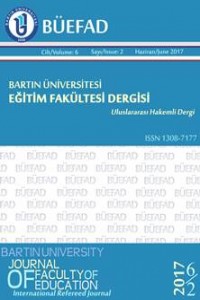Abstract
Osmanlı İmparatorluğu; aşiretten beyliğe, beylikten devlete, devletten
ise cihan imparatorluğuna geçerken, kurumsallaşma döneminin en önemli ve öne
çıkmış eğitim kurumlardan biri olan medreselerde eğitim ve öğretimin Arap
Dili’nde yapılmasını sağlamış ve böylece kendine has bir eğitim ve öğretim
sistemi oluşturmuştur. Bununla birlikte Osmanlı İmparatorluğu’nun bilime ve
bilim adamlarına önem vermesi, eğitim ve öğretim kurumlarını parasız yapması ve
bu kurumlarda eğitim öğretim faaliyetlerini yerine getiren öğrencilerin barınma
ihtiyaclarını karşılaması, Osmanlı toplumunu eğitim ve öğretime teşvik ederken,
ilim hayatının kısa süre içerisinde ilerlemesini ve yaygınlaşmasını
sağlamıştır. Bu bağlamda o dönemin eğitim kurumları olan medreselerde okutulan
Arap Dili, genellikle nakli ilimlerden oluşan Kur’an tefsiri, Hadis ve İslam
fıkhı gibi dini eğitime yönelik olmuşsada İstanbul’un fethinden sonra akli
ilimlerin verilmesi ve tahsili için öğrenilmesi zorunlu olan bir dile
dönüşmüştür. Bununla beraber eğitim ve öğretimin yenilenmesi eğitim kurumları
olan medreselerde eğitim düzeyini yükseltmiş, medreselerin gelişmesini sağlamış
ve sayılarını arttırmıştır. Bu medreselerde okutulan ilmi eserler ve onlara
kaynak teşkil eden kitaplar, Arap dilinde yazılmıştır. Bu durum Arap Dili’nin
öğrenilmesi ve öğretilmesini kaçınılmaz kılmıştır. İşte bu çalışmada; Osmanlı
medreselerinde, eğitim ve öğretim dili olan Arapça’nın, öğretiminin hem
medreselerin yapısı hem de eğitim-öğretim metodlarına değinmek suretiyle nasıl
ve hangi boyutlarda yapıldığına dair tespitlerde bulunmaya çalıştık.
References
- Adıvar, A. (1943). Osmanlı türklerinde ilim. İstanbul: Maarif Matbaası.
- Akgündüz, H. (1997). Klasik dönem osmanlı medrese sistemi. İstanbul: Ulusal Yayınlar.
- Arslan, İ. (2008). Abdurrahmân el-câmî ve el-fevâidü’z-ziyâiyye adlı eseri. (Yayımlanmamış doktora tezi). Dokuz Eylül Üniversitesi, İzmir.
- Aşıkpaşazâde (1332). Tevârih-i âl-i osman. İstanbul: Ali Bey Neşri.
- Bahşi, T. (2013). Nahiv öğretiminde manzûm eserler “ibn mâlik’in el-elfiyye’si örneği”, Ümit Güneş. II. Türkiye Lisansüstü Çalışmalar Kongresi Bildiriler Kitabı – V Cilt. Isparta, 12-15 Mayıs 2016, İstanbul s. 233 – 250.
Abstract
Madrasas which were one of the most important and famous educational
establishments of the Ottoman Empire in the transitional period from a tribe to
a principality, from a principality to a state, from a state to a world empire
made education and training possible in Arabic language and in this way formed
a special education and training system. The fact that Ottoman Empire attached
importance to scientific issues and scientists, the educational establishments
were then free, the need of pupils for sheltering was met enabled scientific
life to advance and become popular in a short span of time as well as
encouraging the Ottoman society in terms of education and training. In this
context, Arabic which was taught in madrasas turned into a compulsory language
for the purpose of training pupils in fundamental Islamic sciences for
religious education. Fundamental Islamic sciences are generally composed of
interpretation of the Koran, the prophet Muhammad's sayings/deeds and Islamic
law. Arabic was also compulsory in madrasas to teach rational sciences after
the conquest of Istanbul. Besides, the innovation of the education and learning
system raised education levels of madrasas, enabled them to advance and
increased their numbers. Scientific works and reference books were written in
Arabic language. This situation made teaching and learning of this language
indispensable. In this study, we touched upon the educative structure of
Madrasas and teaching-training methods. In doing so we also tried to detect how
and in what dimensions the Arabic language which was the language of the
education and training in Ottoman madrasas were taught.
References
- Adıvar, A. (1943). Osmanlı türklerinde ilim. İstanbul: Maarif Matbaası.
- Akgündüz, H. (1997). Klasik dönem osmanlı medrese sistemi. İstanbul: Ulusal Yayınlar.
- Arslan, İ. (2008). Abdurrahmân el-câmî ve el-fevâidü’z-ziyâiyye adlı eseri. (Yayımlanmamış doktora tezi). Dokuz Eylül Üniversitesi, İzmir.
- Aşıkpaşazâde (1332). Tevârih-i âl-i osman. İstanbul: Ali Bey Neşri.
- Bahşi, T. (2013). Nahiv öğretiminde manzûm eserler “ibn mâlik’in el-elfiyye’si örneği”, Ümit Güneş. II. Türkiye Lisansüstü Çalışmalar Kongresi Bildiriler Kitabı – V Cilt. Isparta, 12-15 Mayıs 2016, İstanbul s. 233 – 250.
Details
| Journal Section | Articles |
|---|---|
| Authors | |
| Publication Date | June 30, 2017 |
| Published in Issue | Year 2017 Volume: 6 Issue: 2 |
All the articles published in the journal are open access and distributed under the conditions of CommonsAttribution-NonCommercial 4.0 International License

Bartın University Journal of Faculty of Education


